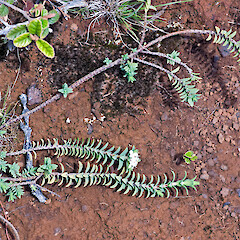Pimelea xenica
Synonyms
None (first described in 2009)
Family
Thymelaeaceae
Flora category
Vascular – Native
Endemic taxon
Yes
Endemic genus
No
Endemic family
No
Structural class
Trees & Shrubs - Dicotyledons
Chromosome number
2n = 36
Current conservation status
The conservation status of all known New Zealand vascular plant taxa at the rank of species and below were reassessed in 2017 using the New Zealand Threat Classification System (NZTCS) – more information about this can be found on the NZTCS website. This report includes a statistical summary and brief notes on changes since 2012 and replaces all previous NZTCS lists for vascular plants.
Please note, threat classifications are often suggested by authors when publications fall between NZTCS assessment periods – an interim threat classification status has not been assessed by the NZTCS panel.
- Conservation status of New Zealand indigenous vascular plants, 2017 . 2018. Peter J. de Lange, Jeremy R. Rolfe, John W. Barkla, Shannel P. Courtney, Paul D. Champion, Leon R. Perrie, Sarah M. Beadel, Kerry A. Ford, Ilse Breitwieser, Ines Schönberger, Rowan Hindmarsh-Walls, Peter B. Heenan and Kate Ladley. Department of Conservation. Source: NZTCS and licensed by DOC for reuse under the Creative Commons Attribution 4.0 International licence.
2017 | Threatened – Nationally Vulnerable | Qualifiers: DP, Sp
Previous conservation statuses
2012 | At Risk – Declining | Qualifiers: DP, Sp
2009 | Not Threatened
2004 | Not Threatened
Brief description
Sprawling shrub to 30 cm tall (usually less) with greyish-hairy stems bearing overlapping pairs of outwrd pointing thin blue-green leaves, hairy white flowers and white fruit inhabiting northern North Island south to Hawke’s Bay. Leaves 4–5.5 mm long by 1.5–2.2 mm long, dished, inrolled when dry.
Distribution
Endemic. New Zealand: North Island (North Auckland (scattered sites from Cape Reinga and North Cape south to Anawhata), South Auckland (Coromandel Peninsula), eastern Bay of Plenty, near East Cape, and near Tangoio, Hawke’s Bay).
Habitat
Mainly coastal or near-coastal but sometimes further inland. A species of low heathland where it grows on open clay pans or within short shrubland dominated by Leptospermum scoparium, Leucopogon fasciculatus, Ozothamnus leptophyllus, Machaerina spp., Phormium cookianum, and Veronica spp. Also found on grassy slopes, open eroding banks on bare soil, and on rock outcrops.
Detailed description
A moderately small, erect or suberect shrub, to 30 cm tall, stems gracile, fastigiate to sprawling. Branching mainly sympodial with some diffuse lateral. Branchlets moderately densely covered by short to long, greyish-white hair. Internodes 0.5–1.2 mm long. Node buttresses 0.1–0.8 mm, brown, lunate to slightly elongate, usually visible on young branchlets but not prominent on leafless stems. Older stems glabrate, grey or grey-brown. Leaves decussate, ascendant to patent, on 0.2–0.5 mm red petioles. Lamina thin, pliable, with a thickened margin, elliptic to ovate, 4.0–5.5 × 1.5–2.2 mm, pale green or glaucous, keeled and adaxially concave (dry leaf margins are often curled inward), midvein not plainly evident abaxially, obtuse or acute, base cuneate. Stomata abundant on adaxial and abaxial sides. Inflorescences terminal on branchlets, 3–5-flowered. Involucral bracts 4, broader than adjacent leaves (4 × 3 mm), partly hiding the flowers. Receptacles sparsely hairy, pedicels 0.3 mm. Plants gynodioecious. Flowers white, opening in salverform fashion, sparsely covered in short hair outside, inside hairy in upper tube and sparsely so in ovary portion. Female tube 3 mm long, ovary portion wrinkled, 2.4 mm long, calyx lobes 1.5 × 1.3 mm. Hermaphrodite tube 4 mm long, ovary portion 1.5 mm, calyx lobes 1.8 × 1.5 mm. Anther dehiscence semi-latrorse. Ovary with sparse hairs on summit and a few short hairs below that. Fruits sub-globose to oblate, fleshy, white, translucent, 5 × 4 mm. Seeds ovoid 2.1 × 1.7 mm, thin crest.
Similar taxa
Pimelea xenica is part of the P. prostrata complex,. Within that complex it is morphologically most similar to P. orthia and P. actea, species with which it shares an erect to suberect growth habitat and pliable leaves with stomata present on both adaxial and abaxial surfaces. It differs from P. orthia by its suberect growth habit and over all shorter stature (up to 400 mm tall) and spreading branches. Pimelea xenica differs from P. actea by its suberect, sprawling habit, more frequent branching and flat leaves which are tightly curled when dry. Pimelea actea is a sparingly branched (whip-like) erect shrublet with flat flat leaves. It is endemic to the Wanganui - Manawatu coast where it grows (or used to grow) in sandy habitats on skeletal or recent soils. Pimelea xenica is confined to heathland, gumland, grassland on heavily leached or weather mature soils; it is endemic to the northern North Island, extending as far south as the Hawke’s Bay.
Flowering
September–April
Flower colours
White
Fruiting
November–June
Propagation technique
Easily grown from semi-hardwood cuttings and rooted pieces. Seed is difficult to germinate. Best grown in a well drained soil in full sun. An excellent plant for the rockery.
Threats
Burrows (2009) notes that one population near Cape Reinga was recently destroyed due to road works. However, he affirms that this species is poorly known. It was assessed in 2012 as ‘At Risk – Declining’ (de Lange et al. 2013) but that was amended in 2017 to ‘Threatened – Nationally Vulnerable’ (de Lange et al. 2018) after the available data was reconsidered.
Etymology
pimelea: Pimeleoides means “resembling Pimelea’’, a genus in the family Thymelaeaceae (Greek, -oides = resembling, like).
Where To Buy
Not commercially available.
Attribution
Factsheet prepared by Peter de Lange with description from: Burrows (2009).
References and further reading
Burrows CJ. 2009. Genus Pimelea (Thymelaeaceae) in New Zealand 2. The endemic Pimelea prostrata and Pimelea urvilliana species complexes. New Zealand Journal of Botany 47(2): 163–229. https://doi.org/10.1080/00288250909509804.
NZPCN Fact Sheet citation
Please cite as: de Lange, P.J. (Year at time of access): Pimelea xenica Fact Sheet (content continuously updated). New Zealand Plant Conservation Network. https://www.nzpcn.org.nz/flora/species/pimelea-xenica/ (Date website was queried)





